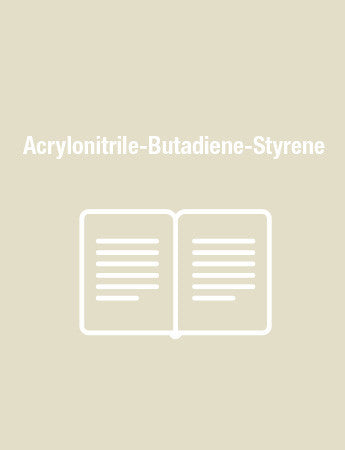Easy Identification of Plastics and Rubbers
Polymers are found in every aspect of our daily lives. Materials must be carefully selected to ensure that properties match performance requirements.
It is often necessary to understand the chemical nature of a material to determine whether it is suitable for a particular application. This book gives guidance on the simple identification of different polymeric materials. Flow charts describe a step-by-step approach to determining the chemical nature of an unknown specimen, starting with simple studies of behaviour on heating and ranging to preparing samples for infrared spectroscopy. The infrared spectra of standard polymers are included for reference.
The book contains sections on:
-Test methods
-Interpreting infrared spectra
-Flow charts for the identification of unknown samples
-Thermoplastics
-Thermosets
-Elastomers
Characteristics of individual polymeric materials are described, including chemical structures, behaviour in tests, common applications and trade names. The infrared spectrum for each polymer is included together with an interpretation of the peaks seen.
The authors of this book are experts in the field of polymer identification. Professor De Moor has been working in industrial organic chemistry since 1979. Noel Roeges has published a renowned book on the interpretation of infrared spectra of organic structures. Verleye Guenaelle is a chemical engineer working in the polymer industry.
Polymer technologists, researchers, scientists, technicians, and students of polymer science will all find this a useful text. It is written in a very practical, easy to follow style. Undergraduate students tested the methodology, bringing samples from waste to identify in the laboratories.
It is often necessary to understand the chemical nature of a material to determine whether it is suitable for a particular application. This book gives guidance on the simple identification of different polymeric materials. Flow charts describe a step-by-step approach to determining the chemical nature of an unknown specimen, starting with simple studies of behaviour on heating and ranging to preparing samples for infrared spectroscopy. The infrared spectra of standard polymers are included for reference.
The book contains sections on:
-Test methods
-Interpreting infrared spectra
-Flow charts for the identification of unknown samples
-Thermoplastics
-Thermosets
-Elastomers
Characteristics of individual polymeric materials are described, including chemical structures, behaviour in tests, common applications and trade names. The infrared spectrum for each polymer is included together with an interpretation of the peaks seen.
The authors of this book are experts in the field of polymer identification. Professor De Moor has been working in industrial organic chemistry since 1979. Noel Roeges has published a renowned book on the interpretation of infrared spectra of organic structures. Verleye Guenaelle is a chemical engineer working in the polymer industry.
Polymer technologists, researchers, scientists, technicians, and students of polymer science will all find this a useful text. It is written in a very practical, easy to follow style. Undergraduate students tested the methodology, bringing samples from waste to identify in the laboratories.
1. Introduction
2. Tests for the Identification of Plastics and Rubbers
2.1 Simple tests
2.2 Recording an IR spectrum
2.3 The identification flow charts
3. Thermoplastics
3.1 What is a thermoplastic?
3.2 Thermoplastic homopolymers
3.3 Thermoplastic copolymers
3.4 Characteristics of individual thermoplastic materials
4. Cellulose and Starch
4.1 Introduction to biopolymers
4.2 Characteristics of individual biopolymers
5. Thermosets
5.1 What is a thermoset?
5.2 Sample preparation for recording an IR-spectrum
5.3 Thermoset materials
5.4 Characteristics of individual thermoset materials
6. Elastomers
6.1 What is an elastomer?
6.2 Recording an IR-spectrum
6.3 The Burchfield colour reaction
6.4 The Liebermann-Storch-Morawski reaction
6.5 Elastomeric materials
6.6 Characteristics of individual elastomers
7. Chemical Products Required
7.1 Introduction
7.2 Organic solvents and reagents
7.3 Inorganic products, acids and bases
2. Tests for the Identification of Plastics and Rubbers
2.1 Simple tests
2.2 Recording an IR spectrum
2.3 The identification flow charts
3. Thermoplastics
3.1 What is a thermoplastic?
3.2 Thermoplastic homopolymers
3.3 Thermoplastic copolymers
3.4 Characteristics of individual thermoplastic materials
4. Cellulose and Starch
4.1 Introduction to biopolymers
4.2 Characteristics of individual biopolymers
5. Thermosets
5.1 What is a thermoset?
5.2 Sample preparation for recording an IR-spectrum
5.3 Thermoset materials
5.4 Characteristics of individual thermoset materials
6. Elastomers
6.1 What is an elastomer?
6.2 Recording an IR-spectrum
6.3 The Burchfield colour reaction
6.4 The Liebermann-Storch-Morawski reaction
6.5 Elastomeric materials
6.6 Characteristics of individual elastomers
7. Chemical Products Required
7.1 Introduction
7.2 Organic solvents and reagents
7.3 Inorganic products, acids and bases
Roger Brown is an internationally acknowledged expert on physical testing and quality assurance of polymers. He has published more than 70 technical papers and three standard textbooks on testing. In addition, he is editor of the journal Polymer Testing and co-editor of the newsletter The Test Report. He has over 25 years experience of running the testing laboratories and services at Rapra. Roger is active on many Standards committees.




